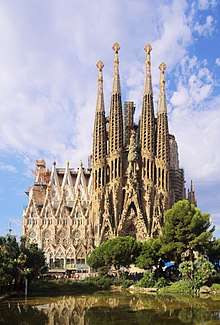Catalan vault
The Catalan vault (Catalan: volta catalana), also called tile vault, Catalan turn, Catalan arch, boveda ceiling (Spanish bóveda 'vault'), or timbrel vault, is a type of low brickwork arch forming a vaulted ceiling that often supports a floor above. It is constructed by laying a first layer of light bricks lengthwise "in space", without centering nor formwork, and has a much gentler curve than most other methods of construction.[1]

Of Roman origin,[2] it is a traditional form in Catalonia (where it is widely used), and has spread around the world through the work of Catalan architects such as Antoni Gaudí and Josep Puig i Cadafalch, and the Valencian architect Rafael Guastavino.
A study on the stability of the Catalan vault is kept at the archive of the Institute of Catalan Studies, where it is said to have been entrusted by Josep Puig i Cadafalch.
Though it is popularly called the Catalan vault, this construction method is found throughout the Mediterranean and the invention of the term "Catalan vault" occurred in 1904 at an architectural congress in Madrid. The earliest known written reference to this vault is from Valencia in 1382, although there were used before in Catalonia, Valencia and Mallorca.
The technique was brought to New Spain (colonial México), and is still used in parts of contemporary Mexico.
See also
References
- López López, David; Domènech Rodríguez, Marta; Palumbo Fernández, Mariana (2014-12-01). ""Brick-topia", the thin-tile vaulted pavilion". Case Studies in Structural Engineering. 2: 33–40. doi:10.1016/j.csse.2014.09.001. ISSN 2214-3998.
- Detail, issue no.: 05/2013 Technology: The Catalan Vault. Accessed 14-Oct-2015
- Beau Peregoy, "9 Dazzling Tiled Archways Devised by Rafael Guastavino", Architectural Digest, January 8, 2016
External links
- Ramage, Michael. "Construction of a Vault". details the process of constructing a six-foot by six-foot vault.
| Wikimedia Commons has media related to Volta Catalana. |
